Modern Drafting Principles for Construction Contracts Analysis
VerifiedAdded on 2022/10/06
|6
|2021
|34
Essay
AI Summary
This essay critically examines the use of language in construction contracts, drawing on the context of a survey favoring plain language in these documents. The analysis compares two contracts, evaluating the clarity and complexity of their language and how this impacts the understanding of the parties involved. It explores the importance of clear language for legal enforceability and the intention of the parties, referencing legal scholars and relevant case law. The essay delves into the application of modern plain language guidelines, considering the roles of various organizations in providing these guidelines, and discusses the Malaysian Subcontract Model Terms. The conclusion emphasizes the significance of simple yet detailed language to avoid ambiguity and ensure effective interpretation in legal disputes. This paper provides a comprehensive overview of contract language, modern drafting principles, and their impact on the construction industry, highlighting the need for clear and accessible contract language.
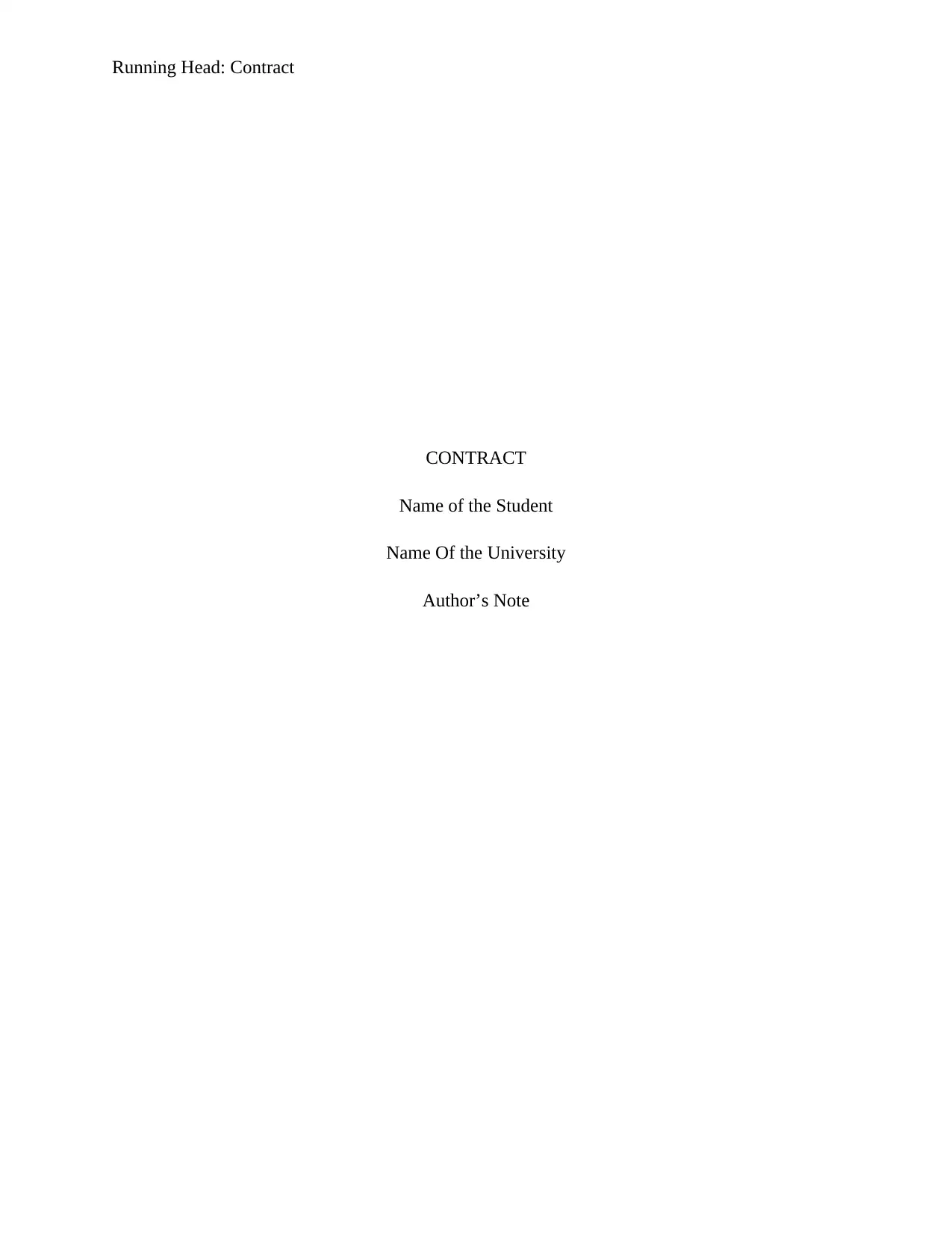
Running Head: Contract
CONTRACT
Name of the Student
Name Of the University
Author’s Note
CONTRACT
Name of the Student
Name Of the University
Author’s Note
Paraphrase This Document
Need a fresh take? Get an instant paraphrase of this document with our AI Paraphraser
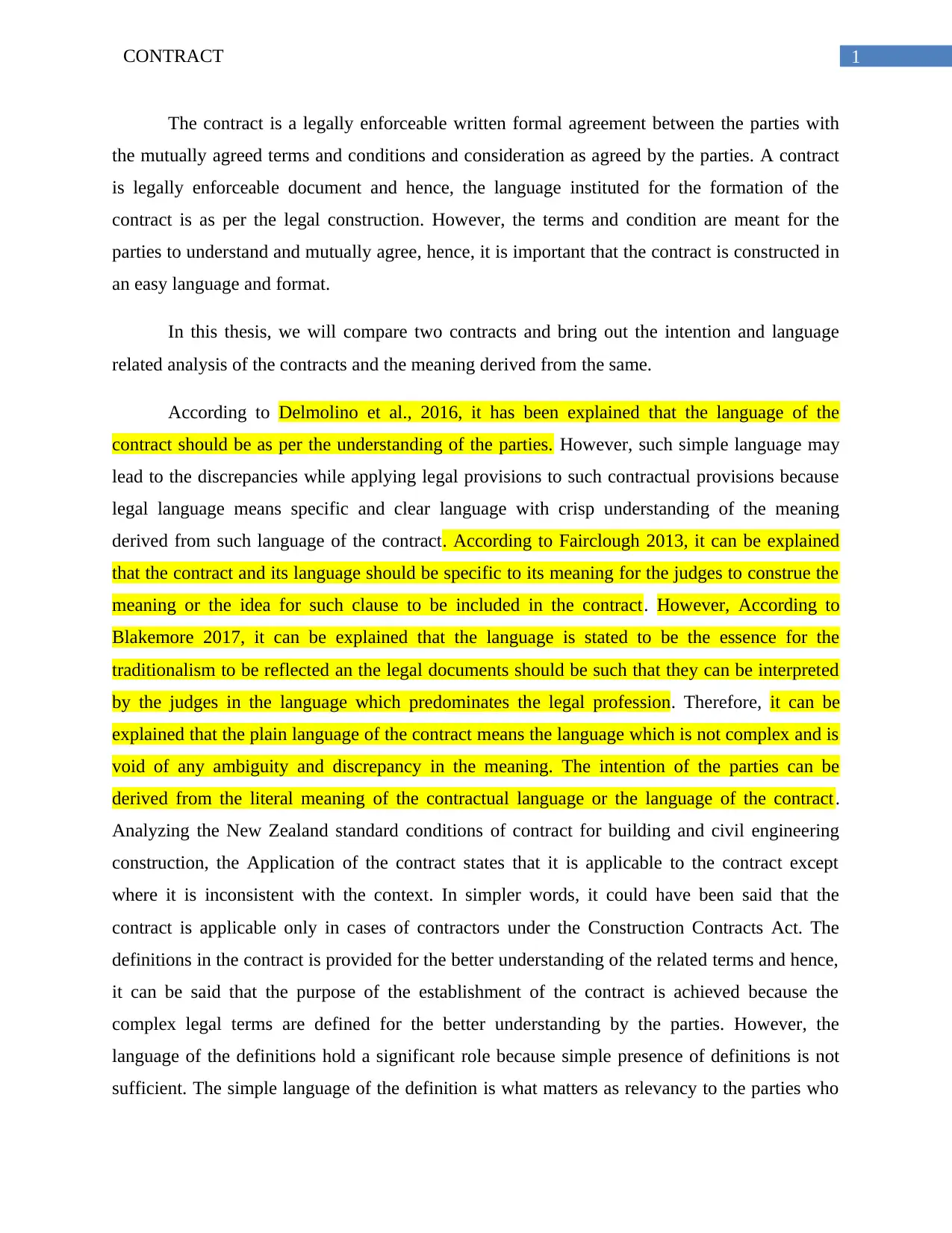
1CONTRACT
The contract is a legally enforceable written formal agreement between the parties with
the mutually agreed terms and conditions and consideration as agreed by the parties. A contract
is legally enforceable document and hence, the language instituted for the formation of the
contract is as per the legal construction. However, the terms and condition are meant for the
parties to understand and mutually agree, hence, it is important that the contract is constructed in
an easy language and format.
In this thesis, we will compare two contracts and bring out the intention and language
related analysis of the contracts and the meaning derived from the same.
According to Delmolino et al., 2016, it has been explained that the language of the
contract should be as per the understanding of the parties. However, such simple language may
lead to the discrepancies while applying legal provisions to such contractual provisions because
legal language means specific and clear language with crisp understanding of the meaning
derived from such language of the contract. According to Fairclough 2013, it can be explained
that the contract and its language should be specific to its meaning for the judges to construe the
meaning or the idea for such clause to be included in the contract. However, According to
Blakemore 2017, it can be explained that the language is stated to be the essence for the
traditionalism to be reflected an the legal documents should be such that they can be interpreted
by the judges in the language which predominates the legal profession. Therefore, it can be
explained that the plain language of the contract means the language which is not complex and is
void of any ambiguity and discrepancy in the meaning. The intention of the parties can be
derived from the literal meaning of the contractual language or the language of the contract.
Analyzing the New Zealand standard conditions of contract for building and civil engineering
construction, the Application of the contract states that it is applicable to the contract except
where it is inconsistent with the context. In simpler words, it could have been said that the
contract is applicable only in cases of contractors under the Construction Contracts Act. The
definitions in the contract is provided for the better understanding of the related terms and hence,
it can be said that the purpose of the establishment of the contract is achieved because the
complex legal terms are defined for the better understanding by the parties. However, the
language of the definitions hold a significant role because simple presence of definitions is not
sufficient. The simple language of the definition is what matters as relevancy to the parties who
The contract is a legally enforceable written formal agreement between the parties with
the mutually agreed terms and conditions and consideration as agreed by the parties. A contract
is legally enforceable document and hence, the language instituted for the formation of the
contract is as per the legal construction. However, the terms and condition are meant for the
parties to understand and mutually agree, hence, it is important that the contract is constructed in
an easy language and format.
In this thesis, we will compare two contracts and bring out the intention and language
related analysis of the contracts and the meaning derived from the same.
According to Delmolino et al., 2016, it has been explained that the language of the
contract should be as per the understanding of the parties. However, such simple language may
lead to the discrepancies while applying legal provisions to such contractual provisions because
legal language means specific and clear language with crisp understanding of the meaning
derived from such language of the contract. According to Fairclough 2013, it can be explained
that the contract and its language should be specific to its meaning for the judges to construe the
meaning or the idea for such clause to be included in the contract. However, According to
Blakemore 2017, it can be explained that the language is stated to be the essence for the
traditionalism to be reflected an the legal documents should be such that they can be interpreted
by the judges in the language which predominates the legal profession. Therefore, it can be
explained that the plain language of the contract means the language which is not complex and is
void of any ambiguity and discrepancy in the meaning. The intention of the parties can be
derived from the literal meaning of the contractual language or the language of the contract.
Analyzing the New Zealand standard conditions of contract for building and civil engineering
construction, the Application of the contract states that it is applicable to the contract except
where it is inconsistent with the context. In simpler words, it could have been said that the
contract is applicable only in cases of contractors under the Construction Contracts Act. The
definitions in the contract is provided for the better understanding of the related terms and hence,
it can be said that the purpose of the establishment of the contract is achieved because the
complex legal terms are defined for the better understanding by the parties. However, the
language of the definitions hold a significant role because simple presence of definitions is not
sufficient. The simple language of the definition is what matters as relevancy to the parties who
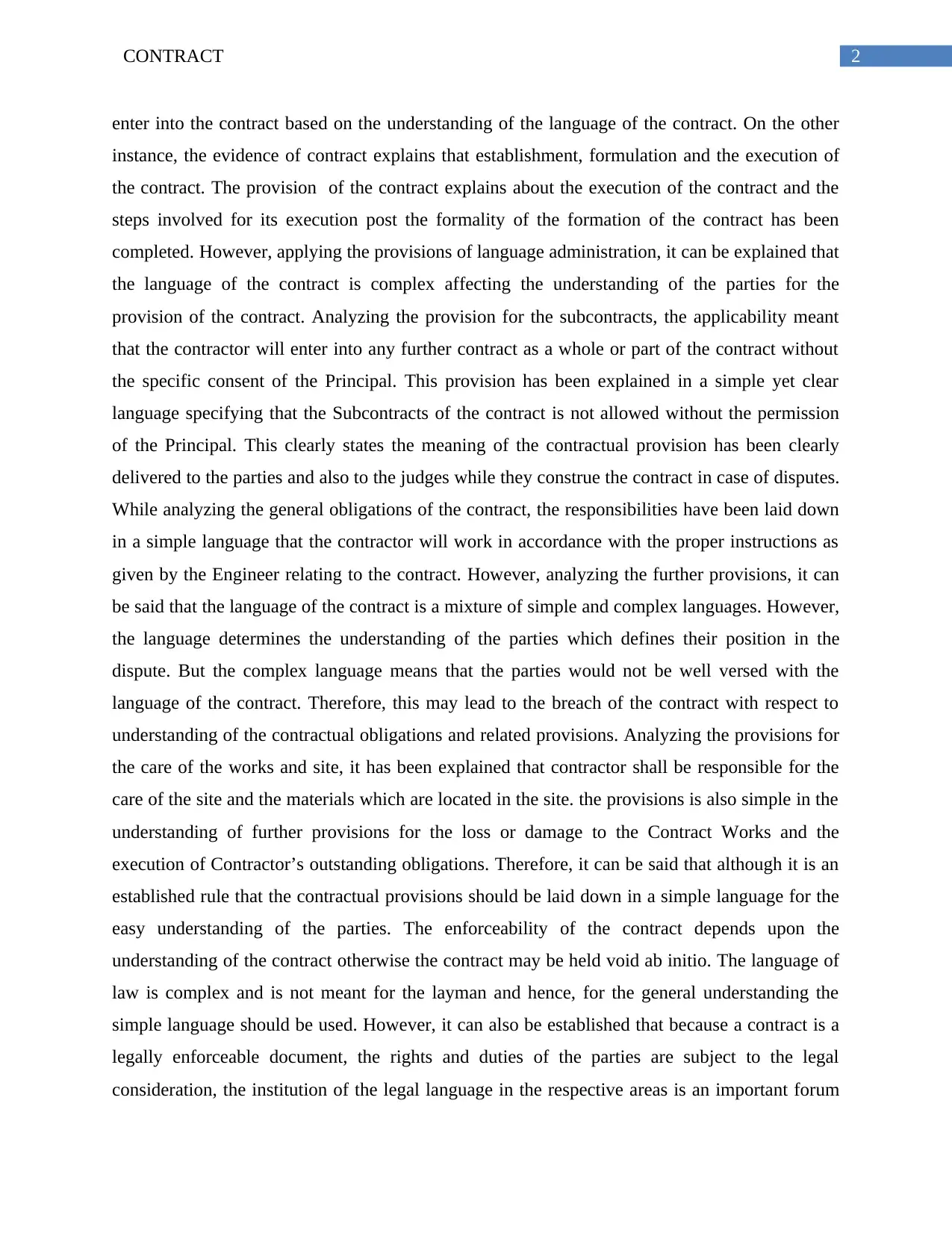
2CONTRACT
enter into the contract based on the understanding of the language of the contract. On the other
instance, the evidence of contract explains that establishment, formulation and the execution of
the contract. The provision of the contract explains about the execution of the contract and the
steps involved for its execution post the formality of the formation of the contract has been
completed. However, applying the provisions of language administration, it can be explained that
the language of the contract is complex affecting the understanding of the parties for the
provision of the contract. Analyzing the provision for the subcontracts, the applicability meant
that the contractor will enter into any further contract as a whole or part of the contract without
the specific consent of the Principal. This provision has been explained in a simple yet clear
language specifying that the Subcontracts of the contract is not allowed without the permission
of the Principal. This clearly states the meaning of the contractual provision has been clearly
delivered to the parties and also to the judges while they construe the contract in case of disputes.
While analyzing the general obligations of the contract, the responsibilities have been laid down
in a simple language that the contractor will work in accordance with the proper instructions as
given by the Engineer relating to the contract. However, analyzing the further provisions, it can
be said that the language of the contract is a mixture of simple and complex languages. However,
the language determines the understanding of the parties which defines their position in the
dispute. But the complex language means that the parties would not be well versed with the
language of the contract. Therefore, this may lead to the breach of the contract with respect to
understanding of the contractual obligations and related provisions. Analyzing the provisions for
the care of the works and site, it has been explained that contractor shall be responsible for the
care of the site and the materials which are located in the site. the provisions is also simple in the
understanding of further provisions for the loss or damage to the Contract Works and the
execution of Contractor’s outstanding obligations. Therefore, it can be said that although it is an
established rule that the contractual provisions should be laid down in a simple language for the
easy understanding of the parties. The enforceability of the contract depends upon the
understanding of the contract otherwise the contract may be held void ab initio. The language of
law is complex and is not meant for the layman and hence, for the general understanding the
simple language should be used. However, it can also be established that because a contract is a
legally enforceable document, the rights and duties of the parties are subject to the legal
consideration, the institution of the legal language in the respective areas is an important forum
enter into the contract based on the understanding of the language of the contract. On the other
instance, the evidence of contract explains that establishment, formulation and the execution of
the contract. The provision of the contract explains about the execution of the contract and the
steps involved for its execution post the formality of the formation of the contract has been
completed. However, applying the provisions of language administration, it can be explained that
the language of the contract is complex affecting the understanding of the parties for the
provision of the contract. Analyzing the provision for the subcontracts, the applicability meant
that the contractor will enter into any further contract as a whole or part of the contract without
the specific consent of the Principal. This provision has been explained in a simple yet clear
language specifying that the Subcontracts of the contract is not allowed without the permission
of the Principal. This clearly states the meaning of the contractual provision has been clearly
delivered to the parties and also to the judges while they construe the contract in case of disputes.
While analyzing the general obligations of the contract, the responsibilities have been laid down
in a simple language that the contractor will work in accordance with the proper instructions as
given by the Engineer relating to the contract. However, analyzing the further provisions, it can
be said that the language of the contract is a mixture of simple and complex languages. However,
the language determines the understanding of the parties which defines their position in the
dispute. But the complex language means that the parties would not be well versed with the
language of the contract. Therefore, this may lead to the breach of the contract with respect to
understanding of the contractual obligations and related provisions. Analyzing the provisions for
the care of the works and site, it has been explained that contractor shall be responsible for the
care of the site and the materials which are located in the site. the provisions is also simple in the
understanding of further provisions for the loss or damage to the Contract Works and the
execution of Contractor’s outstanding obligations. Therefore, it can be said that although it is an
established rule that the contractual provisions should be laid down in a simple language for the
easy understanding of the parties. The enforceability of the contract depends upon the
understanding of the contract otherwise the contract may be held void ab initio. The language of
law is complex and is not meant for the layman and hence, for the general understanding the
simple language should be used. However, it can also be established that because a contract is a
legally enforceable document, the rights and duties of the parties are subject to the legal
consideration, the institution of the legal language in the respective areas is an important forum
⊘ This is a preview!⊘
Do you want full access?
Subscribe today to unlock all pages.

Trusted by 1+ million students worldwide
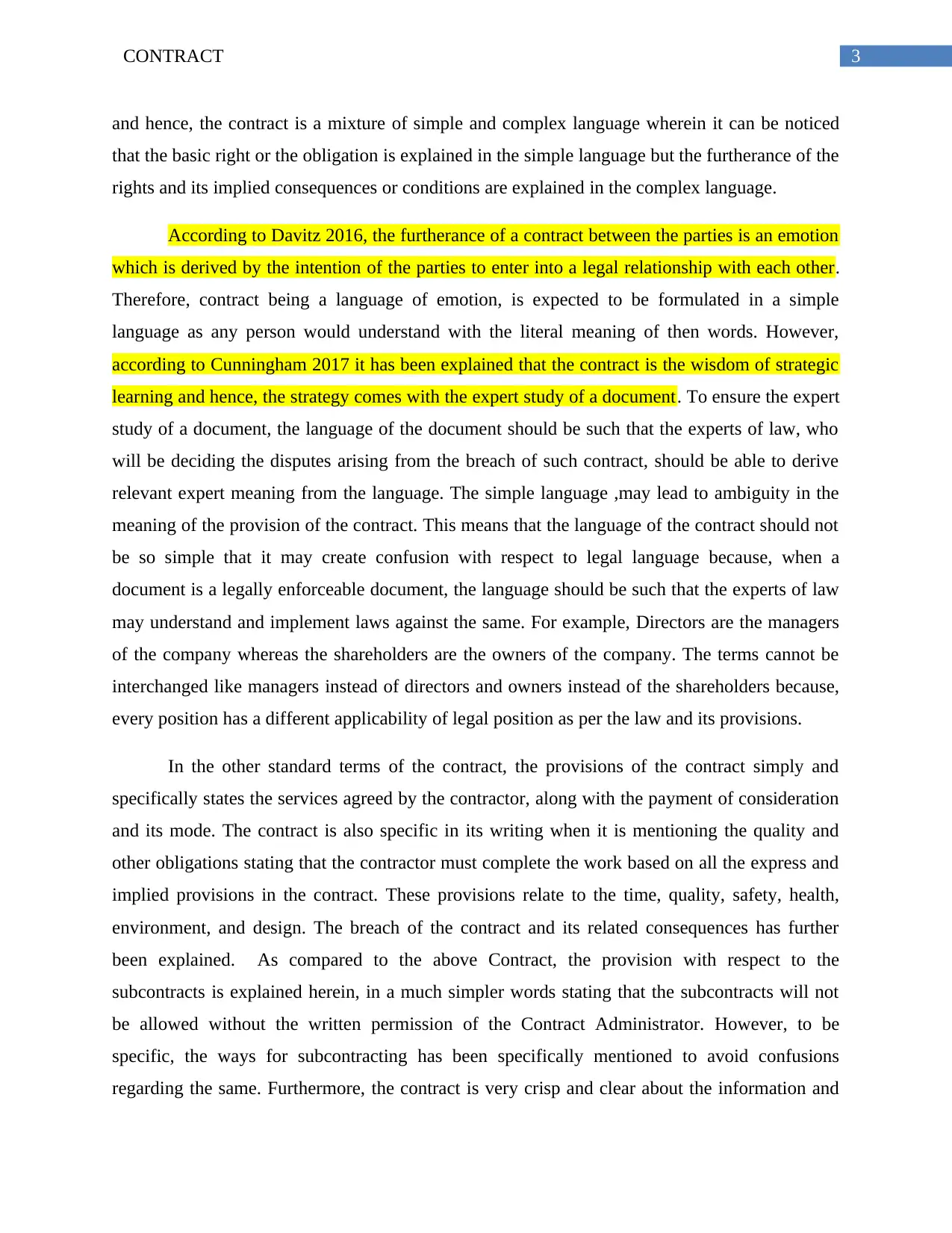
3CONTRACT
and hence, the contract is a mixture of simple and complex language wherein it can be noticed
that the basic right or the obligation is explained in the simple language but the furtherance of the
rights and its implied consequences or conditions are explained in the complex language.
According to Davitz 2016, the furtherance of a contract between the parties is an emotion
which is derived by the intention of the parties to enter into a legal relationship with each other.
Therefore, contract being a language of emotion, is expected to be formulated in a simple
language as any person would understand with the literal meaning of then words. However,
according to Cunningham 2017 it has been explained that the contract is the wisdom of strategic
learning and hence, the strategy comes with the expert study of a document. To ensure the expert
study of a document, the language of the document should be such that the experts of law, who
will be deciding the disputes arising from the breach of such contract, should be able to derive
relevant expert meaning from the language. The simple language ,may lead to ambiguity in the
meaning of the provision of the contract. This means that the language of the contract should not
be so simple that it may create confusion with respect to legal language because, when a
document is a legally enforceable document, the language should be such that the experts of law
may understand and implement laws against the same. For example, Directors are the managers
of the company whereas the shareholders are the owners of the company. The terms cannot be
interchanged like managers instead of directors and owners instead of the shareholders because,
every position has a different applicability of legal position as per the law and its provisions.
In the other standard terms of the contract, the provisions of the contract simply and
specifically states the services agreed by the contractor, along with the payment of consideration
and its mode. The contract is also specific in its writing when it is mentioning the quality and
other obligations stating that the contractor must complete the work based on all the express and
implied provisions in the contract. These provisions relate to the time, quality, safety, health,
environment, and design. The breach of the contract and its related consequences has further
been explained. As compared to the above Contract, the provision with respect to the
subcontracts is explained herein, in a much simpler words stating that the subcontracts will not
be allowed without the written permission of the Contract Administrator. However, to be
specific, the ways for subcontracting has been specifically mentioned to avoid confusions
regarding the same. Furthermore, the contract is very crisp and clear about the information and
and hence, the contract is a mixture of simple and complex language wherein it can be noticed
that the basic right or the obligation is explained in the simple language but the furtherance of the
rights and its implied consequences or conditions are explained in the complex language.
According to Davitz 2016, the furtherance of a contract between the parties is an emotion
which is derived by the intention of the parties to enter into a legal relationship with each other.
Therefore, contract being a language of emotion, is expected to be formulated in a simple
language as any person would understand with the literal meaning of then words. However,
according to Cunningham 2017 it has been explained that the contract is the wisdom of strategic
learning and hence, the strategy comes with the expert study of a document. To ensure the expert
study of a document, the language of the document should be such that the experts of law, who
will be deciding the disputes arising from the breach of such contract, should be able to derive
relevant expert meaning from the language. The simple language ,may lead to ambiguity in the
meaning of the provision of the contract. This means that the language of the contract should not
be so simple that it may create confusion with respect to legal language because, when a
document is a legally enforceable document, the language should be such that the experts of law
may understand and implement laws against the same. For example, Directors are the managers
of the company whereas the shareholders are the owners of the company. The terms cannot be
interchanged like managers instead of directors and owners instead of the shareholders because,
every position has a different applicability of legal position as per the law and its provisions.
In the other standard terms of the contract, the provisions of the contract simply and
specifically states the services agreed by the contractor, along with the payment of consideration
and its mode. The contract is also specific in its writing when it is mentioning the quality and
other obligations stating that the contractor must complete the work based on all the express and
implied provisions in the contract. These provisions relate to the time, quality, safety, health,
environment, and design. The breach of the contract and its related consequences has further
been explained. As compared to the above Contract, the provision with respect to the
subcontracts is explained herein, in a much simpler words stating that the subcontracts will not
be allowed without the written permission of the Contract Administrator. However, to be
specific, the ways for subcontracting has been specifically mentioned to avoid confusions
regarding the same. Furthermore, the contract is very crisp and clear about the information and
Paraphrase This Document
Need a fresh take? Get an instant paraphrase of this document with our AI Paraphraser
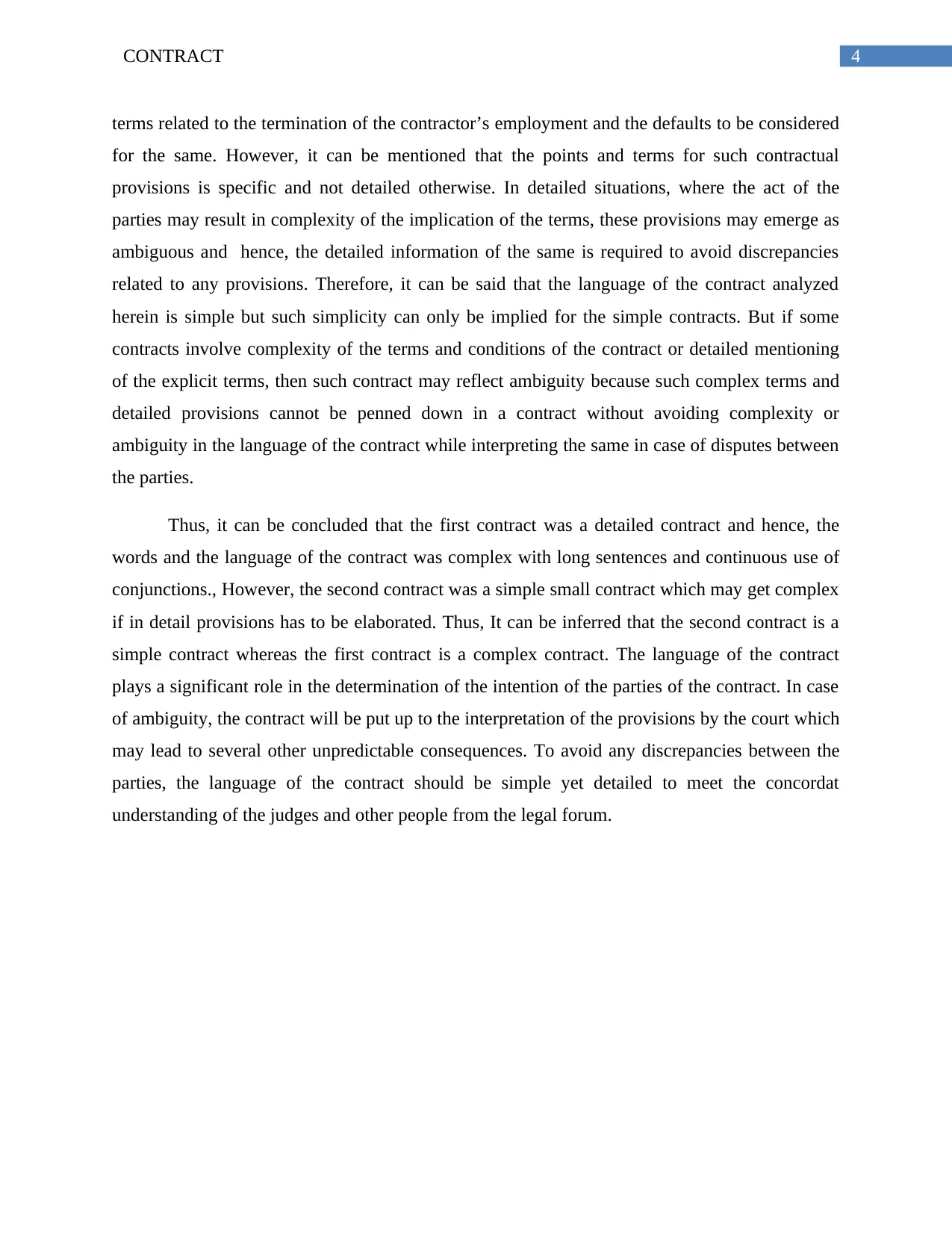
4CONTRACT
terms related to the termination of the contractor’s employment and the defaults to be considered
for the same. However, it can be mentioned that the points and terms for such contractual
provisions is specific and not detailed otherwise. In detailed situations, where the act of the
parties may result in complexity of the implication of the terms, these provisions may emerge as
ambiguous and hence, the detailed information of the same is required to avoid discrepancies
related to any provisions. Therefore, it can be said that the language of the contract analyzed
herein is simple but such simplicity can only be implied for the simple contracts. But if some
contracts involve complexity of the terms and conditions of the contract or detailed mentioning
of the explicit terms, then such contract may reflect ambiguity because such complex terms and
detailed provisions cannot be penned down in a contract without avoiding complexity or
ambiguity in the language of the contract while interpreting the same in case of disputes between
the parties.
Thus, it can be concluded that the first contract was a detailed contract and hence, the
words and the language of the contract was complex with long sentences and continuous use of
conjunctions., However, the second contract was a simple small contract which may get complex
if in detail provisions has to be elaborated. Thus, It can be inferred that the second contract is a
simple contract whereas the first contract is a complex contract. The language of the contract
plays a significant role in the determination of the intention of the parties of the contract. In case
of ambiguity, the contract will be put up to the interpretation of the provisions by the court which
may lead to several other unpredictable consequences. To avoid any discrepancies between the
parties, the language of the contract should be simple yet detailed to meet the concordat
understanding of the judges and other people from the legal forum.
terms related to the termination of the contractor’s employment and the defaults to be considered
for the same. However, it can be mentioned that the points and terms for such contractual
provisions is specific and not detailed otherwise. In detailed situations, where the act of the
parties may result in complexity of the implication of the terms, these provisions may emerge as
ambiguous and hence, the detailed information of the same is required to avoid discrepancies
related to any provisions. Therefore, it can be said that the language of the contract analyzed
herein is simple but such simplicity can only be implied for the simple contracts. But if some
contracts involve complexity of the terms and conditions of the contract or detailed mentioning
of the explicit terms, then such contract may reflect ambiguity because such complex terms and
detailed provisions cannot be penned down in a contract without avoiding complexity or
ambiguity in the language of the contract while interpreting the same in case of disputes between
the parties.
Thus, it can be concluded that the first contract was a detailed contract and hence, the
words and the language of the contract was complex with long sentences and continuous use of
conjunctions., However, the second contract was a simple small contract which may get complex
if in detail provisions has to be elaborated. Thus, It can be inferred that the second contract is a
simple contract whereas the first contract is a complex contract. The language of the contract
plays a significant role in the determination of the intention of the parties of the contract. In case
of ambiguity, the contract will be put up to the interpretation of the provisions by the court which
may lead to several other unpredictable consequences. To avoid any discrepancies between the
parties, the language of the contract should be simple yet detailed to meet the concordat
understanding of the judges and other people from the legal forum.
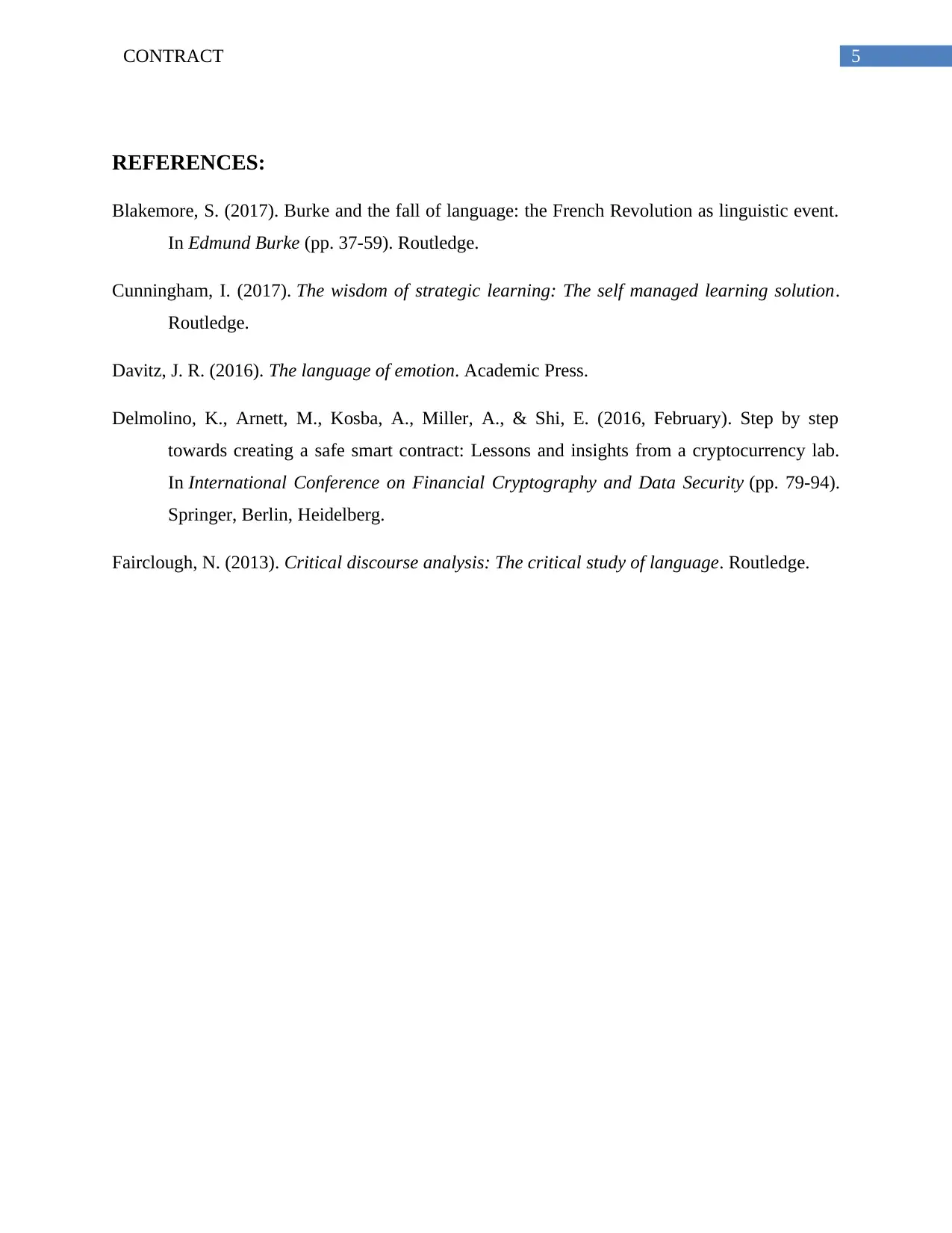
5CONTRACT
REFERENCES:
Blakemore, S. (2017). Burke and the fall of language: the French Revolution as linguistic event.
In Edmund Burke (pp. 37-59). Routledge.
Cunningham, I. (2017). The wisdom of strategic learning: The self managed learning solution.
Routledge.
Davitz, J. R. (2016). The language of emotion. Academic Press.
Delmolino, K., Arnett, M., Kosba, A., Miller, A., & Shi, E. (2016, February). Step by step
towards creating a safe smart contract: Lessons and insights from a cryptocurrency lab.
In International Conference on Financial Cryptography and Data Security (pp. 79-94).
Springer, Berlin, Heidelberg.
Fairclough, N. (2013). Critical discourse analysis: The critical study of language. Routledge.
REFERENCES:
Blakemore, S. (2017). Burke and the fall of language: the French Revolution as linguistic event.
In Edmund Burke (pp. 37-59). Routledge.
Cunningham, I. (2017). The wisdom of strategic learning: The self managed learning solution.
Routledge.
Davitz, J. R. (2016). The language of emotion. Academic Press.
Delmolino, K., Arnett, M., Kosba, A., Miller, A., & Shi, E. (2016, February). Step by step
towards creating a safe smart contract: Lessons and insights from a cryptocurrency lab.
In International Conference on Financial Cryptography and Data Security (pp. 79-94).
Springer, Berlin, Heidelberg.
Fairclough, N. (2013). Critical discourse analysis: The critical study of language. Routledge.
⊘ This is a preview!⊘
Do you want full access?
Subscribe today to unlock all pages.

Trusted by 1+ million students worldwide
1 out of 6
Related Documents
Your All-in-One AI-Powered Toolkit for Academic Success.
+13062052269
info@desklib.com
Available 24*7 on WhatsApp / Email
![[object Object]](/_next/static/media/star-bottom.7253800d.svg)
Unlock your academic potential
Copyright © 2020–2025 A2Z Services. All Rights Reserved. Developed and managed by ZUCOL.




